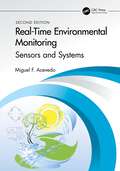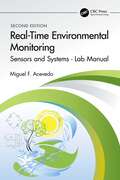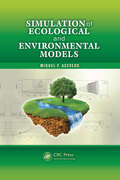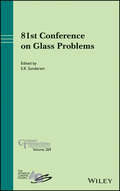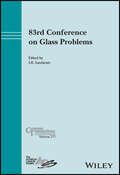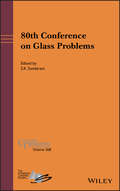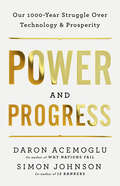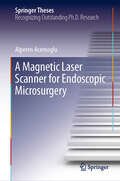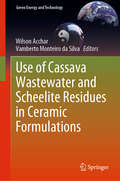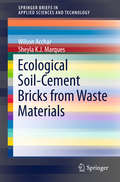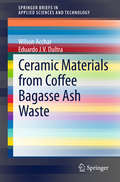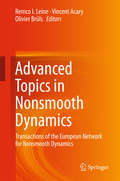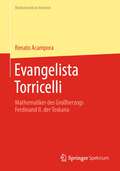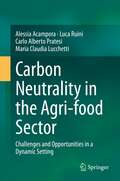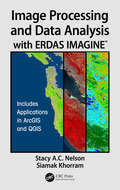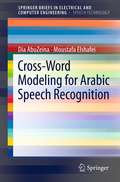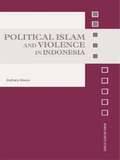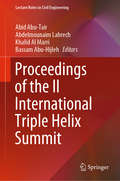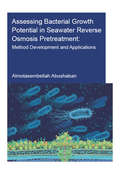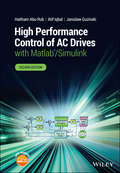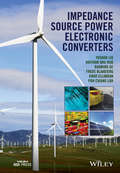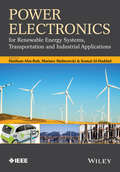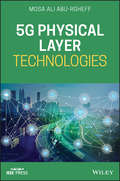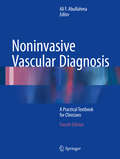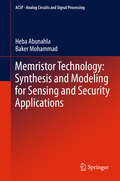- Table View
- List View
Real-Time Environmental Monitoring: Sensors and Systems - Textbook
by Miguel F. AcevedoWritten 10 years after the publication of the first edition, this updated edition of Real-Time Environmental Monitoring: Sensors and Systems introduces the fundamentals of environmental monitoring based on electronic sensors, instruments, systems, and software that allow continuous and long-term ecological and environmental data collection. It accomplishes two objectives: explains how to use sensors for building more complex instruments, systems, and databases, and introduces a variety of sensors and systems employed to measure environmental variables in air, water, soils, vegetation canopies, and wildlife observation and tracking. This second edition is thoroughly updated in every aspect of technology and data, and each theoretical chapter is taught parallel with a hands-on application lab manual. Emphasizes real-time monitoring as an emerging area for environmental assessment and compliance and covers the fundamentals on how to develop sensors and systems Presents several entirely new topics not featured in the first edition, including remote sensing and GIS, machine learning, weather radar and satellites, groundwater monitoring, spatial analysis, and habitat monitoring Includes applications to many environmental and ecological systems Uses a practical, hands-on approach with the addition of an accompanying lab manual, which students can use to deepen their understanding, based on the author’s 40 years of academic experience Intended for upper-level undergraduate and graduate students, taking courses in civil and environmental engineering, electrical engineering, mechanical engineering, geosciences, and environmental sciences, as well as professionals working in environmental services, and researchers and academics in engineering.
Real-Time Environmental Monitoring: Sensors and Systems - Lab Manual
by Miguel F. AcevedoThis lab manual is a companion to the second edition of the textbook Real-Time Environmental Monitoring: Sensors and Systems. Tested in pedagogical settings by the author for many years, it includes applications with state-of-the-art sensor technology and programs such as R, Python, Arduino, PHP, HTML, and SQL. It helps students and instructors in science and engineering better understand how to use and design a variety of sensors, and how to build systems and databases when monitoring different environments such as soil, water, and air. Examples of low-cost and open-access systems are included and can serve as the basis of learning tools for the concepts and techniques described in the textbook. Furthermore, the manual provides links to websites and scripts in R that allow learning how to analyze a variety of datasets available from repositories and databases maintained by many agencies and institutions. The first hands-on environmental monitoring lab manual written in tutorial style and classroom tested. Includes 14 lab guides that parallel the theory developed in 14 chapters in the companion textbook. Provides clear step-by-step protocols to understand basic and advanced theory through applicable exercises and problems. Injects a practical implementation of the existing textbook. A valuable guide for students and practitioners worldwide engaged in efforts to develop, employ, and maintain environmental monitors. Intended for upper-level undergraduate and graduate students taking courses in electrical engineering, civil and environmental engineering, mechanical engineering, geosciences, and environmental sciences, as well as instructors who teach these courses. Professionals working in fields such as environmental services, and researchers and academics in engineering will also benefit from the range of topics included in this lab manual.
Simulation of Ecological and Environmental Models
by Miguel F. AcevedoGiven the importance of interdisciplinary work in sustainability, Simulation of Ecological and Environmental Models introduces the theory and practice of modeling and simulation as applied in a variety of disciplines that deal with earth systems, the environment, ecology, and human-nature interactions. Based on the author's many years of teaching g
81st Conference on Glass Problems (Ceramic Transactions Series #269)
by ACerS (American Ceramics Society, The)The 81st Conference on Glass Problems (GPC) was organized by the Kazuo Inamori School of Engineering, The New York State College of Ceramics, Alfred University, Alfred, NY 14802 and The Glass Manufacturing Industry Council (GMIC), Westerville, OH 43082. The Program Director was S. K. Sundaram, Inamori Professor of Materials Science and Engineering, Kazuo Inamori School of Engineering, The New York State College of Ceramics, Alfred University, Alfred, NY 14802. The Conference Director was Bob Lipetz, Executive Director, Glass Manufacturing Industry Council (GMIC), Westerville, OH 43082. The GPC Advisory Board (AB) included the Program Director, the Conference Director, and several industry representatives. The Board assembled the technical program. Donna Banks of the GMIC coordinated the events and provided support. Due to world-wide COVID-19 pandemic, the conference was a virtual event. It started with a full-day plenary session followed by technical sessions.
83rd Conference on Glass Problems, Ceramic Transactions Volume 271 (Ceramic Transactions Series #271)
by ACerS (American Ceramics Society, The)83rd Conference on Glass Problems
80th Conference on Glass Problems (Ceramic Transactions Series #268)
by ACerSThe 80th Glass Problem Conference (GPC) was organized by the Kazuo Inamori School of Engineering, The New York State College of Ceramics, Alfred University, Alfred, NY 14802 and The Glass Manufacturing Industry Council (GMIC), Westerville, OH 43082. The Program Director was S. K. Sundaram, Inamori Professor of Materials Science and Engineering, Kazuo Inamori School of Engineering, The New York State College of Ceramics, Alfred University, Alfred, NY 14802. The Conference Director was Robert Weisenburger Lipetz, Executive Director, Glass Manufacturing Industry Council (GMIC), Westerville, OH 43082. The GPC Advisory Board (AB) included the Program Director, the Conference Director, and several industry representatives. The Board assembled the technical program. Donna Banks of the GMIC coordinated the events and provided support. The Conference started with a half-day plenary session followed by technical sessions. The themes and chairs of four technical sessions were as follows: Melting and CombustionUyi Iyoha, Praxair, Inc., Peachtree City, GA, Jan Schep, Owens-Illinois, Inc., Perrysburg, OH, and Justin Wang, Guardian Industries, Auburn Hills, MI Batch, Environmental, and ModelingPhil Tucker, Johns Manville, Littleton, CO and Chris Tournour, Corning Inc., Corning, NY RefractoriesLarry McCloskey, Anchor Acquisition, LLC, Lancaster, OH and Eric Dirlam, Ardagh Group, Muncie, IN Sensors and ControlAdam Polycn, Vitro Architectural Glass, Cheswick, PA and Glenn Neff, Glass Service USA, Inc., Stuart, FL
Power and Progress: Our Thousand-Year Struggle Over Technology and Prosperity
by Daron Acemoglu Simon JohnsonThe bestselling co-author of Why Nations Fail and the bestselling co-author of 13 Bankers deliver a bold reinterpretation of economics and history that will fundamentally change how you see the world A thousand years of history and contemporary evidence make one thing clear: progress depends on the choices we make about technology. New ways of organizing production and communication can either serve the narrow interests of an elite or become the foundation for widespread prosperity. The wealth generated by technological improvements in agriculture during the European Middle Ages was captured by the nobility and used to build grand cathedrals, while peasants remained on the edge of starvation. The first hundred years of industrialization in England delivered stagnant incomes for working people. And throughout the world today, digital technologies and artificial intelligence undermine jobs and democracy through excessive automation, massive data collection, and intrusive surveillance. It doesn&’t have to be this way. Power and Progress demonstrates the path of technology was once—and may again—be brought under control. Cutting-edge technological advances can become empowering and democratizing tools, but not if all major decisions remain in the hands of a few hubristic tech leaders. With their bold reinterpretation of economics and history, Daron Acemoglu and Simon Johnson fundamentally change how we see the world, providing the vision needed to redirect innovation so it again benefits most people.
A Magnetic Laser Scanner for Endoscopic Microsurgery (Springer Theses)
by Alperen AcemogluThis book focuses on the design, development, and characterization of a compact magnetic laser scanner for microsurgical applications. In addition, it proposes a laser incision depth controller to be used in soft tissue microsurgeries.The use of laser scanners in soft tissue microsurgery results in high quality ablations with minimal thermal damage to surrounding tissue. However, current scanner technologies for microsurgery are limited to free-beam lasers, which require direct line-of-sight to the surgical site, from outside the patient. Developing compact laser micromanipulation systems is crucial to introducing laser-scanning capabilities in hard-to-reach surgical sites, e.g., vocal cords.In this book, the design and fabrication of a magnetically actuated endoscopic laser scanner have been shown, one that introduces high-speed laser scanning for high quality, non-contact tissue ablations in narrow workspaces. Static and dynamic characterization of the system, its teleoperation through a tablet device, and its control modelling for automated trajectory executions have been shown using a fabricated and assembled prototype. Following this, the book discusses how the laser position and velocity control capabilities of the scanner can be used to design a laser incision depth controller to assist surgeons during operations.
Use of Cassava Wastewater and Scheelite Residues in Ceramic Formulations (Green Energy and Technology)
by Wilson Acchar Vamberto Monteiro da SilvaThis book presents original results on the use of cassava wastewater as a substitute for potable water in ceramic formulations. It evaluates the physical and mechanical properties as well as the microstructure of the materials produced, comparing the products obtained from the incorporating effluent with the conventional materials used in the construction industry.
Ecological Soil-Cement Bricks from Waste Materials
by Wilson Acchar Sheyla K. J. MarquesThis book proposes the use of waste from oil drilling andsugar cane bagasse ash in the production of ecologically friendly soil-cementbricks. It offers a viable alternative to the traditional bricks available onthe market, which use wood as fuel: manufacturing bricks from waste is lesscostly and does not require the consumption of trees and forests. It alsoproposes an alternative to the current discharging of the above-mentioned typesof waste in sanitary landfills, avoiding additional environmental problems.
Ceramic Materials from Coffee Bagasse Ash Waste (SpringerBriefs in Applied Sciences and Technology)
by Wilson Acchar Eduardo J. V. DultraThis book proposes the use of coffee bagasse ash (CBA) waste as raw material to be used in ceramic formulations. The approach presented here is a solution to a current ambiental problem as CBA waste is discharged in high amounts in agriculture. The authors analyze the potencial of CBA as a material to substitute feldspar in tile production.
Advanced Topics in Nonsmooth Dynamics: Transactions of the European Network for Nonsmooth Dynamics
by Vincent Acary Remco Leine Olivier BrülsThis book discusses emerging topics in the area of nonsmooth dynamics research, such as numerical methods for nonsmooth systems, impact laws for multi-collisions, nonlinear vibrations and control of nonsmooth systems. It documents original work of researchers at the European Network for NonSmooth Dynamics (ENNSD), which provides a cooperation platform for researchers in the field and promotes research focused on nonsmooth dynamics and its applications. Since the establishment of the network in 2012, six ENNSD symposia have been organized at different European locations. The network brings together 40 specialists from 9 different countries in and outside Europe and a wealth of scientific knowledge has been gathered and developed by this group of experts in recent years. The book is of interest to both new and experienced researchers in the field of nonsmooth dynamics. Each chapter is written in such a way as to provide an introduction to the topic for researchers from other fields.
Evangelista Torricelli: Mathematiker des Großherzogs Ferdinand II. der Toskana (Mathematik im Kontext)
by Renato AcamporaDie meisten Nichtmathematiker werden Torricelli durch das nach ihm benannte Ausflussgesetz kennen, wonach die Geschwindigkeit eines aus einem Gefäss austretenden Wasserstrahls proportional zur Quadratwurzel aus der Füllhöhe ist, ebenso wie durch seinen Nachweis des Luftdrucks mithilfe seines Vakuumexperiments. Viel bedeutender aber sind seine Leistungen auf dem Gebiet der Mathematik als virtuoser Vertreter von Cavalieris umstrittener Indivisiblenmethode, wobei er seine Ergebnisse aber stets mit Beweisen nach der allgemein anerkannten „Art der Alten“ absicherte. Auf diese Weise gelang ihm die Quadratur der Parabeln und Hyperbeln höherer Ordnung, der Zykloide, der logarithmischen Spirale (ebenso wie deren Rektifikation) und die Bestimmung der Schwerpunkte zahlreicher ebener und räumlicher Figuren.
Carbon Neutrality in the Agri-food Sector: Challenges and Opportunities in a Dynamic Setting
by Alessia Acampora Luca Ruini Carlo Alberto Pratesi Maria Claudia LucchettiThis book deals with the in-depth study of sustainability issues in the agri-food sector. In particular, a critical analysis of the current situation was developed and the future prospects of the sector on the issue of managing the environmental variable and the impacts relating to food production and consumption have been analyzed. Furthermore, the state of implementation and best practices relating to the carbon neutrality model in the agri-food sector were analyzed and models for the development of a new food production system were proposed with particular reference to the reduction of emissions, regeneration of natural resources, the elimination of waste and the reuse of production by-products. The main objectives of the book are to analyze the current situation and trends regarding carbon neutrality schemes and the connection with other greening programs, to identify and analyze the carbon-related labels, their methodology and their conformity assessment mechanisms and to understand possible key drivers for carbon neutrality or low carbon achievements in the agri-food sector.Today companies are acting on climate change pressures implementing carbon-neutral strategies for their brands and products. These frontrunner companies have identified a specific competitive advantage and are exploiting it to become the pioneers and the reference model for the carbon neutral implementation. This book will provide detailed and practical insights on how your organization can take positive action and be part of the global response developing a carbon neutral business.
Image Processing and Data Analysis with ERDAS IMAGINE®
by Stacy A.C. Nelson Siamak KhorramRemotely sensed data, in the form of digital images captured from spaceborne and airborne platforms, provide a rich analytical and observational source of information about the current status, as well as changes occurring in, on, and around the Earth’s surface. The data products, or simply images processed from these platforms, provide an additional advantage in that geographic areas or regions of interest can be revisited on a regular cycle. This revisit cycle allows geospatial analysts and natural resource managers to explore changing conditions over time. Image Processing and Data Analysis with ERDAS IMAGINE® explains the principles behind the processing of remotely sensed data in a simple, easy to understand, and "how-to" format. Organized as a step-by-step guide with exercises adapted from original research and using publicly available imagery, such as NASA Landsat, ESA Sentinel-2, Orthophotos, and others, this book gives readers the ability to quickly gain the practical experience needed to navigate the ERDAS IMAGINE® software as well as learn certain applications in Esri’s ArcMap ArcGIS for Desktop software and Quantum the GIS (QGIS) open source applications package. It also helps readers to easily move beyond the information presented in this book and tackle more advanced skills. Written by two professors with long experience in remote sensing and image processing, this book is a useful guide and reference for both undergraduate and graduate students, researchers, instructors, managers, and agency professionals who are involved in the study of Earth systems and the environment.
Cross-Word Modeling for Arabic Speech Recognition (SpringerBriefs in Speech Technology)
by Dia Abuzeina Moustafa ElshafeiCross-Word Modeling for Arabic Speech Recognition utilizes phonological rules in order to model the cross-word problem, a merging of adjacent words in speech caused by continuous speech, to enhance the performance of continuous speech recognition systems. The author aims to provide an understanding of the cross-word problem and how it can be avoided, specifically focusing on Arabic phonology using an HHM-based classifier.
Political Islam and Violence in Indonesia (Asian Security Studies)
by Zachary AbuzaPolitical Islam and Violence in Indonesia presents a penetrating new investigation of religious radicalism in the largest Muslim country in the world. Indonesia is a country long known for its diversity and tolerant brand of Islam. However, since the fall of Suharto, a more intolerant form of Islam has been growing, one whose adherents have carried out terrorist attacks, waged sectarian war, and voiced strident anti-Western rhetoric. Zachary Abuza’s unique analysis of radical Islam draws upon primary documents such as Jemaah Islamiyah’s operations manual, interviews, and recorded testimonies of politicians, religious figures, and known militants, as well as personal interviews with numerous security and intelligence experts in Indonesia and elsewhere, to paint a picture at once guardedly optimistic about the future of Indonesian democracy and concerned about the increasing role of conservative and radical Islam in Indonesian society. This book will be of great interest to students of Indonesian politics, Asian studies, political violence and security studies in general.
Proceedings of the II International Triple Helix Summit (Lecture Notes in Civil Engineering #43)
by Abid Abu-Tair Abdelmounaim Lahrech Khalid Al Marri Bassam Abu-HijlehThis volume gathers the latest advances and innovations in the triple helix of university-industry-government relations, as presented by leading international researchers at the II International Triple Helix Summit 2018, held in Dubai, UAE on November 10-13, 2018, which brought together experts, practitioners and academics across disciplines that address the dynamics of government, industry and academia. It covers analysis, theory, measurements and empirical enquiry in all aspects of university-industry-government interactions, as well as the international bases and dimensions of triple helix relations, their impacts, and social, economic, political, cultural, health and environmental implications. It also examines the role of government/academia/industry in building innovation-based cities and nations, and in transforming nations into knowledge-based sustainable economies. The contributions, which were selected by means of a rigorous international peer-review process, highlight numerous exciting ideas that will spur novel research directions and foster multidisciplinary collaboration among different specialists.
Assessing Bacterial Growth Potential in Seawater Reverse Osmosis Pretreatment: Method Development and Applications (IHE Delft PhD Thesis Series)
by Almotasembellah AbushabanSeawater desalination is increasingly being used as a means to augment freshwater supplies in regions with high water stress, and reverse osmosis is increasingly the technology of choice because of the low energy consumption. However, seawater reverse osmosis (SWRO) systems suffer from various types of fouling, which can increase energy consumption and the use of chemicals during SWRO operation. In practice, pre-treatment systems are put in place to reduce the particulate and biological fouling potential of SWRO feed water. However, simple, reliable and accurate methods to assess the extent to which biological fouling potential is reduced during pre-treatment are not available for seawater. This research developed a new method to measure bacterial growth potential (BGP) using the native bacterial consortium in seawater. New reagents to extract and detect ATP in microbial cells were specifically developed for seawater. The new lysis and detection reagents overcame the salt interference in seawater and allow low detection of total ATP, free ATP and microbial ATP in seawater. Incorporating a filtration step further increased the sensitivity of the method six fold, enabling ATP detection of ultra-low levels of microbial ATP in seawater. The newly developed ATP-based BGP method was applied to monitor and assess the pre-treatment of five full-scale seawater desalination plants around the world. A good correlation was observed between BGP measured in SWRO feed water and the pressure drop increase in the SWRO systems, suggesting the applicability of using the ATP-based BGP method as a biofouling indicator in SWRO. Furthermore, a safe level of BGP ( In the future, on-line monitoring of BGP in SWRO feed water may further reduce the consumption of chemicals and energy and improve the overall sustainability of seawater desalination by reverse osmosis.
High Performance Control of AC Drives with Matlab/Simulink
by Haitham Abu-Rub Jaroslaw Guzinski Atif IqbalHigh Performance Control of AC Drives with Matlab®/Simulink Explore this indispensable update to a popular graduate text on electric drive techniques and the latest converters used in industryThe Second Edition of High Performance Control of AC Drives with Matlab®/Simulink delivers an updated and thorough overview of topics central to the understanding of AC motor drive systems. The book includes new material on medium voltage drives, covering state-of-the-art technologies and challenges in the industrial drive system, as well as their components, and control, current source inverter-based drives, PWM techniques for multilevel inverters, and low switching frequency modulation for voltage source inverters.This book covers three-phase and multiphase (more than three-phase) motor drives including their control and practical problems faced in the field (e.g., adding LC filters in the output of a feeding converter), are considered.The new edition contains links to Matlab®/Simulink models and PowerPoint slides ideal for teaching and understanding the material contained within the book. Readers will also benefit from the inclusion of:A thorough introduction to high performance drives, including the challenges and requirements for electric drives and medium voltage industrial applicationsAn exploration of mathematical and simulation models of AC machines, including DC motors and squirrel cage induction motorsA treatment of pulse width modulation of power electronic DC-AC converter, including the classification of PWM schemes for voltage source and current source invertersExaminations of harmonic injection PWM and field-oriented control of AC machinesVoltage source and current source inverter-fed drives and their controlModelling and control of multiphase motor drive systemSupported with a companion website hosting online resources.Perfect for senior undergraduate, MSc and PhD students in power electronics and electric drives, High Performance Control of AC Drives with Matlab®/Simulink will also earn a place in the libraries of researchers working in the field of AC motor drives and power electronics engineers in industry.
Impedance Source Power Electronic Converters
by Haitham Abu-Rub Omar Ellabban Yushan Liu Baoming Ge Frede Blaabjerg Poh Chiang LohImpedance Source Power Electronic Converters brings together state of the art knowledge and cutting edge techniques in various stages of research related to the ever more popular impedance source converters/inverters. Significant research efforts are underway to develop commercially viable and technically feasible, efficient and reliable power converters for renewable energy, electric transportation and for various industrial applications. This book provides a detailed understanding of the concepts, designs, controls, and application demonstrations of the impedance source converters/inverters. Key features: Comprehensive analysis of the impedance source converter/inverter topologies, including typical topologies and derived topologies. Fully explains the design and control techniques of impedance source converters/inverters, including hardware design and control parameter design for corresponding control methods. Presents the latest power conversion solutions that aim to advance the role of power electronics into industries and sustainable energy conversion systems. Compares impedance source converter/inverter applications in renewable energy power generation and electric vehicles as well as different industrial applications. Provides an overview of existing challenges, solutions and future trends. Supported by calculation examples, simulation models and results. Highly accessible, this is an invaluable resource for researchers, postgraduate/graduate students studying power electronics and its application in industry and renewable energy conversion as well as practising R&D engineers. Readers will be able to apply the presented material for the future design of the next generation of efficient power electronic converters/inverters.
Power Electronics for Renewable Energy Systems, Transportation and Industrial Applications
by Haitham Abu-Rub Kamal Al-Haddad Mariusz MalinowskiCompiles current research into the analysis and design of power electronic converters for industrial applications and renewable energy systems, presenting modern and future applications of power electronics systems in the field of electrical vehiclesWith emphasis on the importance and long-term viability of Power Electronics for Renewable Energy this book brings together the state of the art knowledge and cutting-edge techniques in various stages of research. The topics included are not currently available for practicing professionals and aim to enable the reader to directly apply the knowledge gained to their designs. The book addresses the practical issues of current and future electric and plug-in hybrid electric vehicles (PHEVs), and focuses primarily on power electronics and motor drives based solutions for electric vehicle (EV) technologies. Propulsion system requirements and motor sizing for EVs is discussed, along with practical system sizing examples. Key EV battery technologies are explained as well as corresponding battery management issues. PHEV power system architectures and advanced power electronics intensive charging infrastructures for EVs and PHEVs are detailed. EV/PHEV interface with renewable energy is described, with practical examples. This book explores new topics for further research needed world-wide, and defines existing challenges, concerns, and selected problems that comply with international trends, standards, and programs for electric power conversion, distribution, and sustainable energy development. It will lead to the advancement of the current state-of-the art applications of power electronics for renewable energy, transportation, and industrial applications and will help add experience in the various industries and academia about the energy conversion technology and distributed energy sources. Combines state of the art global expertise to present the latest research on power electronics and its application in transportation, renewable energy and different industrial applicationsOffers an overview of existing technology and future trends, with discussion and analysis of different types of converters and control techniques (power converters, high performance power devices, power system, high performance control system and novel applications)Systematic explanation to provide researchers with enough background and understanding to go deeper in the topics covered in the book
5G Physical Layer Technologies (Wiley - IEEE)
by Mosa Ali Abu-RgheffWritten in a clear and concise manner, this book presents readers with an in-depth discussion of the 5G technologies that will help move society beyond its current capabilities. It perfectly illustrates how the technology itself will benefit both individual consumers and industry as the world heads towards a more connected state of being. Every technological application presented is modeled in a schematic diagram and is considered in depth through mathematical analysis and performance assessment. Furthermore, published simulation data and measurements are checked. Each chapter of 5G Physical Layer Technologies contains texts, mathematical analysis, and applications supported by figures, graphs, data tables, appendices, and a list of up to date references, along with an executive summary of the key issues. Topics covered include: the evolution of wireless communications; full duplex communications and full dimension MIMO technologies; network virtualization and wireless energy harvesting; Internet of Things and smart cities; and millimeter wave massive MIMO technology. Additional chapters look at millimeter wave propagation losses caused by atmospheric gases, rain, snow, building materials and vegetation; wireless channel modeling and array mutual coupling; massive array configurations and 3D channel modeling; massive MIMO channel estimation schemes and channel reciprocity; 3D beamforming technologies; and linear precoding strategies for multiuser massive MIMO systems. Other features include: In depth coverage of a hot topic soon to become the backbone of IoT connecting devices, machines, and vehicles Addresses the need for green communications for the 21st century Provides a comprehensive support for the advanced mathematics exploited in the book by including appendices and worked examples Contributions from the EU research programmes, the International telecommunications companies, and the International standards institutions (ITU; 3GPP; ETSI) are covered in depth Includes numerous tables and illustrations to aid the reader Fills the gap in the current literature where technologies are not explained in depth or omitted altogether 5G Physical Layer Technologies is an essential resource for undergraduate and postgraduate courses on wireless communications and technology. It is also an excellent source of information for design engineers, research and development engineers, the private-public research community, university research academics, undergraduate and postgraduate students, technical managers, service providers, and all professionals involved in the communications and technology industry.
Noninvasive Vascular Diagnosis
by Ali F. AburahmaThe book provides the newest definitive text on the current techniques used in assessing vascular disorders. Readers will receive authoritative information and will be guided through the establishment and accreditation of a vascular laboratory and introduced to the physics of diagnostic testing. The chapters comprehensively explain the use of ultrasound in diagnosing cerebrovascular, renovascular, visceral ischemia and peripheral arterial disease, as well as venous disorders and deep abdominal vascular conditions. The book contains over 300 illustrations, many of them in color. The book will be invaluable to physicians who treat vascular disorders, surgeons, cardiologists, vascular radiologists and the vascular laboratory staff.
Memristor Technology: Synthesis and Modeling for Sensing and Security Applications
by Heba Abunahla Baker MohammadThis book provides readers with a single-source guide to fabricate, characterize and model memristor devices for sensing applications. The authors describe a correlated, physics-based model to simulate and predict the behavior of devices fabricated with different oxide materials, active layer thickness, and operating temperature. They discuss memristors from various perspectives, including working mechanisms, different synthesis methods, characterization procedures, and device employment in radiation sensing and security applications.
